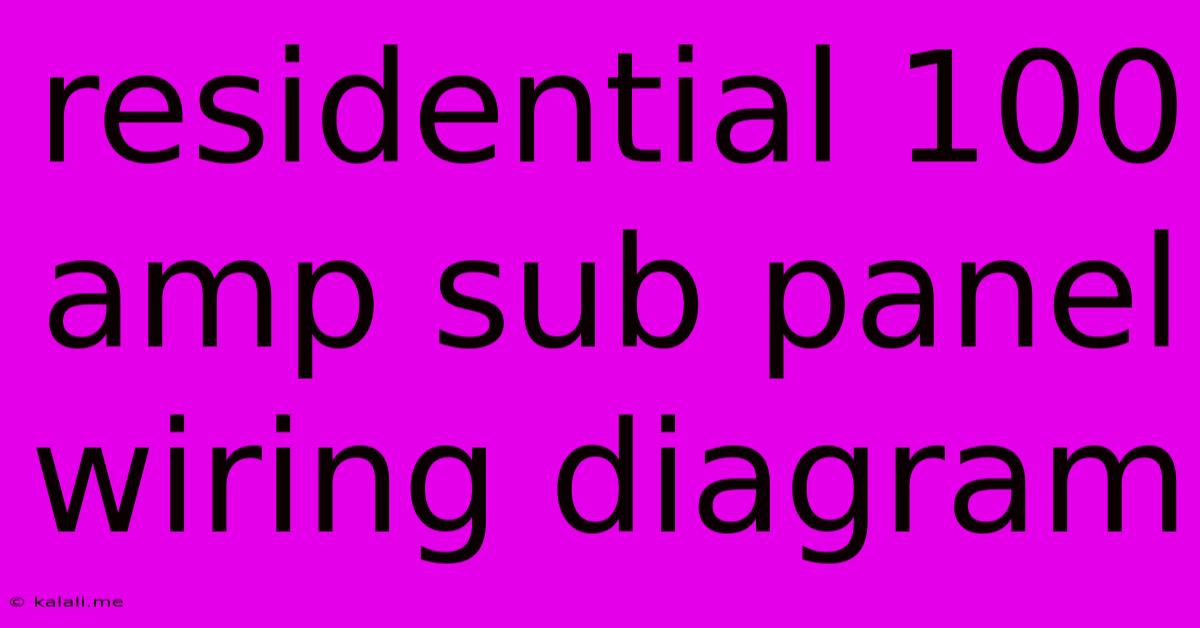Residential 100 Amp Sub Panel Wiring Diagram
Kalali
May 29, 2025 · 3 min read

Table of Contents
Residential 100 Amp Sub Panel Wiring Diagram: A Comprehensive Guide
This article provides a comprehensive guide to understanding and implementing a residential 100 amp sub panel wiring diagram. It's crucial to understand that electrical work can be dangerous, and if you're not comfortable working with electricity, you should always consult a qualified electrician. This guide is for informational purposes only. Improper wiring can lead to fire hazards and electrical shocks.
Understanding the Purpose of a Sub Panel
A sub panel is a secondary electrical panel that distributes power from your main electrical panel to other areas of your home. This is particularly useful for larger homes or those with significant electrical demands in specific areas, like workshops or detached garages. A 100-amp sub panel provides a substantial amount of power for these areas.
Components of a 100 Amp Sub Panel Wiring Diagram
Several key components are involved in a 100-amp sub-panel installation:
- Main Electrical Panel: The source of power for the entire home.
- 100 Amp Sub Panel: The secondary panel distributing power to a specific area.
- Wiring: Typically, a 2-gauge or 4-gauge copper wire (depending on the distance and code requirements) is used for the main feed to the sub panel. Aluminum wire is generally not recommended for sub panel installations.
- Main Breaker (in the main panel): A breaker that protects the entire sub-panel circuit. This will likely be a 100-amp double-pole breaker.
- Circuit Breakers (in the sub panel): Individual breakers protecting various circuits within the sub panel.
- Ground Wire: A crucial safety component that protects against electrical shocks.
- Neutral Wire: Carries the return current to the main panel.
Step-by-Step Guide (Conceptual Overview – Do Not Attempt Without Professional Guidance)
While a detailed diagram is beyond the scope of text, here's a conceptual overview:
-
Planning and Permitting: Secure the necessary permits from your local authorities before starting any electrical work. Proper planning, including determining the number and type of circuits needed for the sub panel, is crucial.
-
Running the Wiring: The wiring from the main panel to the sub panel must be properly routed and secured, adhering to all local building codes and safety regulations. This often involves running the wire through walls, ceilings, or underground.
-
Connecting the Feed Wires: The main feed wires (hot, neutral, and ground) are connected to the appropriate bus bars in both the main panel and the sub panel. This requires careful attention to detail and adherence to color-coding conventions.
-
Grounding: The ground wire must be properly grounded to ensure electrical safety.
-
Installing Circuit Breakers: Install the appropriate circuit breakers in the sub panel to protect the individual circuits.
-
Testing and Inspection: After completion, a thorough inspection is necessary to verify proper wiring and electrical safety. This often includes a test by a qualified electrician to ensure everything is working correctly.
Common Wire Sizes and Considerations:
Choosing the correct wire gauge is critical for safety and preventing voltage drops. The distance between the main panel and the sub panel significantly impacts the wire size required. Consult the National Electrical Code (NEC) for specific requirements based on your location and amperage.
- Short distances: Larger gauge wires (e.g., 2-gauge) might be sufficient.
- Long distances: Smaller gauge wires (e.g., 4-gauge or even larger) will be necessary to minimize voltage drop and ensure adequate power delivery.
Safety Precautions:
- Turn off the power: Always disconnect the power to both the main panel and the sub-panel before starting any wiring work.
- Use appropriate tools: Utilize only the correct tools and equipment for the task.
- Follow code: Adhere strictly to all local electrical codes and safety regulations.
- Seek professional help: If you are not comfortable working with electricity, consult a licensed and qualified electrician.
This article offers a general overview. Remember, electrical work is inherently risky. Consult a qualified electrician to ensure the safe and compliant installation of your 100 amp sub panel. Improper installation can lead to serious hazards. Safety should always be the top priority.
Latest Posts
Latest Posts
-
How To Send Imessage Instead Of Text Message
May 30, 2025
-
How To Say Welcome Back In Spanish
May 30, 2025
-
What Is My Cousin To My Kids
May 30, 2025
-
I Hear Creepy Sounds In My House In Minecraft
May 30, 2025
-
Can More Than One Person Play On A Steam Account
May 30, 2025
Related Post
Thank you for visiting our website which covers about Residential 100 Amp Sub Panel Wiring Diagram . We hope the information provided has been useful to you. Feel free to contact us if you have any questions or need further assistance. See you next time and don't miss to bookmark.